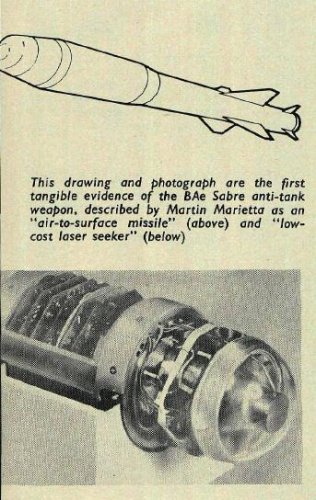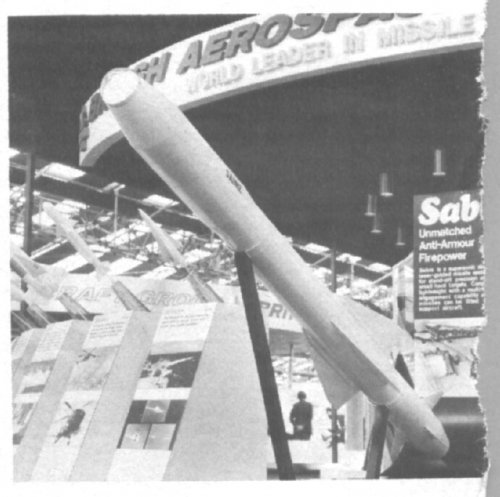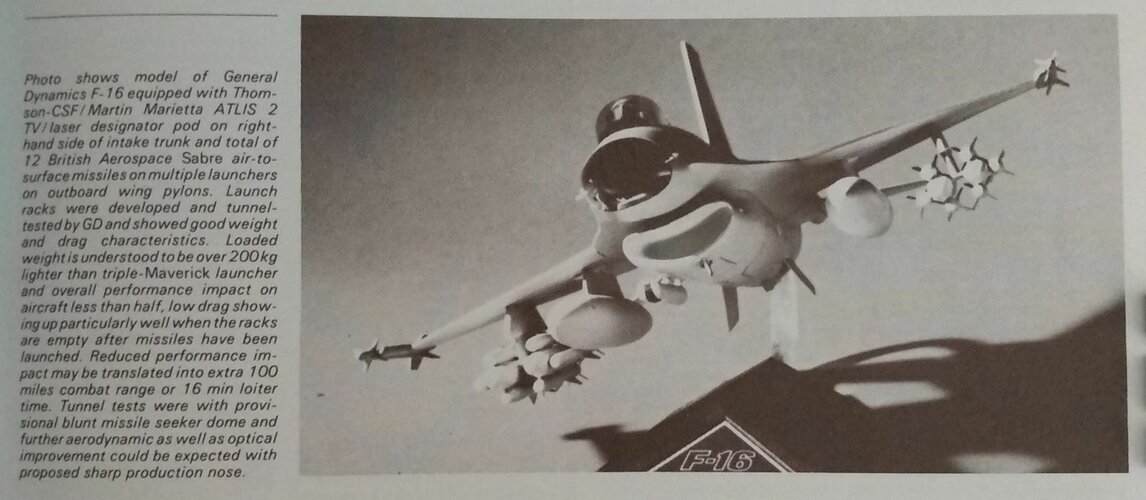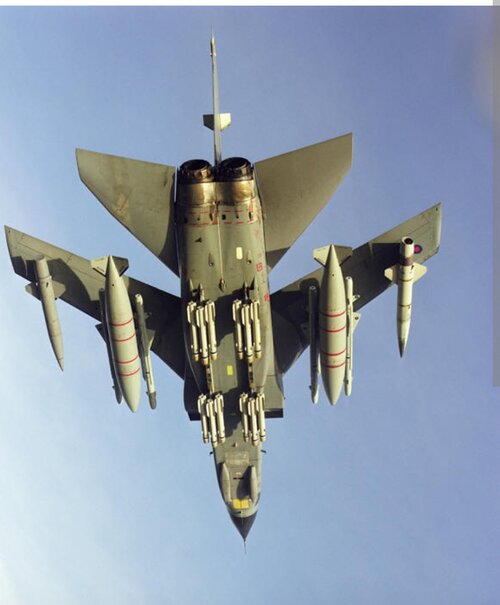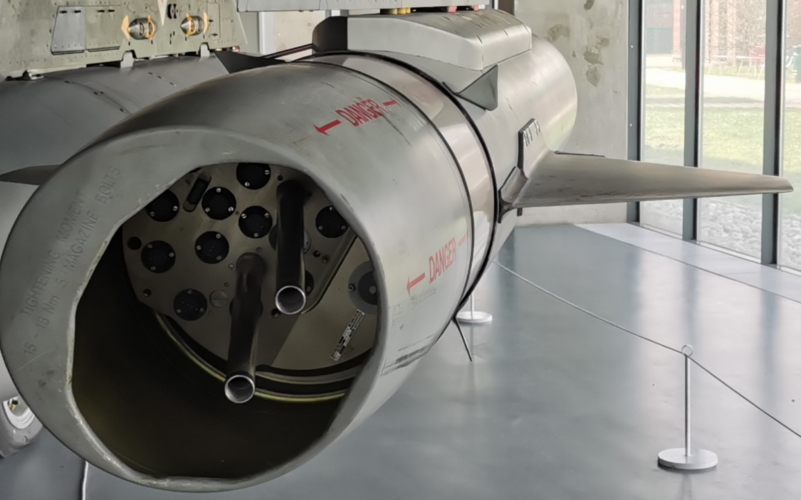As at last year’s Paris Air Show, Aérospatiale was showing both a full-scale and a model AS.30L laser-guided weapon which has now been test-fired from a Jaguar, but of longer-term interest were the details which could be gleaned on the Aérospatiale / MBB project for an air-to-surface version of the Roland SAM, designated ASLL (Air-Sol Léger Laser). A decision on whether to make this an official Euromissile project was postponed recently, so it remains a purely company development which has yet to receive either French or German Government funding. Nevertheless, work has been going on for nearly two years and the weapon is regarded as fairly well defined.
The missile airframe would be basically that of Roland, fitted with the same Thomson-CSF Arie/ laser seeker as the AS.30Land Thomson-Brandt laser-guided 100 mm rocket (see separate item), with a smaller boost motor (because of the already high launch velocity imparted by the carrier aircraft), modifications to the control system and a ‘‘different’’ warhead. Unlike the Roland SAM, the ASLL would not be tubelaunched, so presumably the flip-out destabilisation fins of the surface-launched missile would be fixed for ASLL. How the companies intend to cope with the change in c.g. resulting from the modifications remains to be seen, but size and weight of the system should be such as to allow carriage of six missiles under each wing of, for example, an F-16. Timescale for availability of the 8-10 km range ASLL, the manufacturers feel, should run roughly in parallel with the F-16.
Meanwhile, in UK, the contenders to meet Air Staff Target 1227 have been narrowed to two: the British Aerospace Sabre and a Hunting Engineering cluster bomb, either powered or fitted with wings for launch at stand-off range and medium altitude. Sabre is an exact parallel of ASLL, being an air-launched development of the Rapier SAM using semi-active laser guidance. A Martin Marietta seeker, developed from the company’s Copperhead CLGP unit and displayed on the stand at Hanover alongside an unlabelled line drawing of Sabre, would be fitted, the British company feeling that Martin has now perfected mass production techniques and that no-one else could beat their price. Most of the rest of the missile would be standard Rapier, of which 9,000 have now been built so BAe has high confidence in reliability and quality control of the system. Weight of Sabre would probably be in the region of 60 kg, compared with Rapier’s 43 kg, some of the increase resulting from areas of double-skinning required to meet the environmental demands of air carriage and launch. This is almost exactly the same as that of a Roland round, so a similar number to ASLL could be carried. One of the principal advantages of either ASLL or Sabre compared with, for example, the subsonic US Maverick and Hellfire is their high supersonic speed. Trials on a Martin Marietta simulator, complete with terrain model, have convinced BAe that, because of the reduced time of missile flight, up to four Sabres could be fired on a single pass, each with an 80% single-shot kill probability against a main battle tank. Indeed, the company believes that a guided missile is the only sensible way of fulfilling AST 1227 requirements, maintaining that a cluster bomb dispensing sub-munitions has a relatively low chance of disabling a reasonable number of tanks. Furthermore, the company has doubts about the armour- piercing qualities of bomblets small enough to be dispensed from an AST 1227-sized cluster unit and says that a dangerous 7-10 sec straight-and-level run-in is needed to deliver such a weapon accurately A decision by the RAF Air Staff on whether to go for missiles or cluster bombs for AST 1227 is due in August, although there are indications that the service really wants both. In this case, Sabre may be officially chosen while Hunting is encouraged to continue development on a MoD- sponsored private-venture basis similar to that which resulted in the company’s BL755 cluster bomb. Meanwhile, the British Army is believed to support Sabre, one reason being that it is seen as being more suitable for potential use on the Hawk weapon-training aircraft. With the shortage of close air support for the Army in Germany, they would like to see these aircraft available for operational use, possibly with a ground tradesman acting as electro-optics officer in the back seat.
While Harrier, Jaguar and AST 403 remain the prime candidates for Sabre, the possibility has also been examined of arming, for example, the Lynx helicopter with the weapon, in order to counter the Soviet Hind D which is both faster and more manoeuvrable than it was at first given credit for. Sabre might just also have an air- to-air role from fixed-wing aircraft, but pro- bably only as a last line of self-defense.
The question of a designator pod to work with missiles such as ASLL or Sabre is now the subject of a NATO initiative, according to one industry source at Hanover. Obvious candidates are the Thomson-CSF/ Martin Marietta Atlis 2, Westinghouse Pave Spike C and Northrop Improved LATAR, although in UK Ferranti is favoured to provide an illuminator, possibly on a collaborative basis. Pave Spike pods already bought for RAF Buccaneers are regarded as an interim solution ASLL is clearly linked with Atlis, also on show on the Martin stand, and the Sabre simulator trials were carried out assuming use of the Franco-American designator. The USAF is hoping to revive a clear requirement for an Advanced Laser Designator (ALD) by the end of this year and some industry sources have pointed out that an Anglo-American missile with a Franco-American pod could make a very positive contribution both to standardisation and the two-way street in arms procurement.
Meanwhile, BAe is making an effort to have Sabre adopted by the German Air Force for use on the Alpha Jet, although Hellfire is regarded as currently the strongest contender, and has opened preliminary discussions with Sweden to seduce that country away from the proposed B83. The infra-red seeker from the cancelled Rb72 air-to-air missile is being adapted for use in B83, has been test-flown and proved its ability to discriminate between flares and real targets (a potential problem partly responsible for a version of the BAe SRAAM air-to-air missile dropping out of the AST 1227 competition). It works in the 7-14 μ band and is thus suitable for air-to-ground applications. Nevertheless, it is understood that a proposal may be made to the Swedes to adopt the Sabre airframe and motor with their own seeker, which would then result in a common missile with alternative infra-red or semi-active laser seekers.


